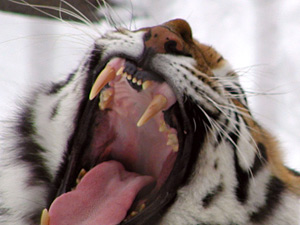 |
 |
 |
 Health & Beauty | June 2006 Health & Beauty | June 2006  
Mexican may have had Fangs for Dentures
 Reuters Reuters


| | Archaeologist and palaeontologist James Chatters said the man's upper and front teeth had been cut off, possibly to insert a ceremonial denture made from the palate of a wolf or a jaguar. |
Mexico City - A man whose 4,500 year-old skeleton was found in Mexico may have worn ceremonial dentures made from wolf or jaguar fangs, in one of the earliest examples of dentistry in the Americas, scientists said on Wednesday.

The skeleton, found buried in volcanic ash beneath a cliff painted with ancient rock art in a remote mountain region of western Mexico, dates from around 2,500 B.C. The man was between 28 and 32 years old and stood about 5 feet 1 inch (1.55 metres) tall, said University of Connecticut researchers.

Archaeologist and palaeontologist James Chatters said the man's upper and front teeth had been cut off, possibly to insert a ceremonial denture made from the palate of a wolf or a jaguar.

"Such a denture might be something like the mouthparts of a predatory animal or some fierce animal of some sort," he said in a telephone interview.

It was also possible the man's teeth had been cut off for cosmetic reasons, or to indicate special status, perhaps as a priest or shaman, Chatters said.

Many pre-Hispanic Mexican cultures revered wild animals like jaguars. The Maya, for example, believed the big cat ruled the underworld and used jaguar pelts in religious ceremonies.

The man may have died from an infection related to his dental work, Chatters said.

"They cut his teeth off right down to gum and exposed the pulp cavity, and he had two abscesses in his mouth at the time he died. Blood poisoning is a possibility there," he said.

Tricia Gabany Guerrero heads the team working at the burial site, which was littered with obsidian flakes.

She said the team only found the remote spot after being led there by elders from the Purepecha Indian group that now lives in the area in Michoacan state. Locals call the skeleton "The Bald Man."

The cliff walls at the site are painted with designs that include calendar symbols, linking the little-studied area to Mexico's more famous cultures, like the Aztecs and Maya.

"It is astounding that we have calendar symbols on the rock art wall that tie this region to the rest of Mesoamerica," she said.

Archaeologists believe that some groups were starting to cultivate corn and squash in this period elsewhere in Mexico. | 
 | |
 |



